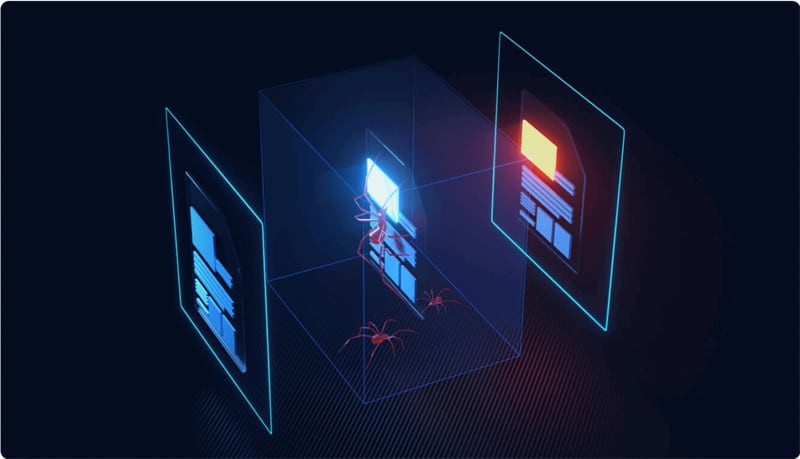
Sandboxing is the act of isolating potentially harmful software programs or executable lines of code so they do not infect other parts of a computer system. Sandboxing is a crucial cybersecurity practice that effectively protects computer systems from zero-day threats. These are threats that a computer system does not recognize and is unable to match with known malware signatures. This makes them likely to slip through traditional threat detection systems.
Sandboxing allows cybersecurity personnel and software developers to safely run code and test applications without putting other components of their IT infrastructure at risk. Using sandboxing in cybersecurity situations adds an extra layer of protection to a computer system because all threats would be quarantined in the “sandbox.”
What is a Sandbox?

A sandbox (or sandbox environment) is an isolated and secure testing ground for codes and software likely to harm other programs in a network. It is made up of components that are used to replicate the features of some hardware components or software programs and simulate computer systems, thereby providing an isolated environment for testing. They prevent applications from accessing resources in a computer system while providing adequate resources for the testing exercise.
You can use a sandbox in many scenarios, for example, visiting an unknown website. Visiting an unknown (or potentially malicious) website on your work computer may be unwise. As a cybersecurity personnel, you should install a web browser in a sandbox environment to access the site. This will limit the spread of malware to the sandbox and keep your computer safe.
Sandboxing also allows cybersecurity professionals to observe how specific malware works so they can develop mitigation measures for it and quickly detect when it is present in other systems. Organizations conduct this security research to proactively protect themselves from cyber attacks because cybercriminals often upgrade their tactics to circumvent security measures.
How to Set Up a Sandbox Environment
You can set up sandbox environments in different ways, depending on what they will be used for. They run on virtual machines which emulate computers and use software resources rather than hardware components. Any software you run or code you execute in the virtual machine stays contained in the machine.
The sandbox environment you create should have similar features to the real environment. It should also have RAM, storage, and processing power. There are many sandboxes you can install on Windows and MacOS. They offer similar services, but some might be more reliable than others and have the features you need. It would help if you read online reviews before picking any.
You can also set up a sandbox in a cloud computing environment, thereby keeping potential cyber threats away from the hardware components of your IT infrastructure. Some sandboxes come as web browser extensions so you can assess the threats from your browser.
Benefits of Sandboxing in Cybersecurity
Cybersecurity professionals and organizations benefit in the following ways when they use a sandbox:
- Safeguard their IT infrastructure from malware
Malware can destroy a company’s IT infrastructure, so running potentially malicious code in a sandbox will stop malware from infecting the system, thus preserving its integrity.
- Safely test software before launch
When launching new software, updating an existing one, or writing new code, you should test them to examine their vulnerabilities. It would be best if you did this in a sandbox to avoid complications.
- Securely evaluate the security status of unknown software
If you are working with a new software solutions provider and want to run new software, you should be careful because their software program might be corrupted. You should run it in an isolated environment first to find and evaluate any threat it may contain.
- Isolate zero-day threats
Occasionally, computers encounter threats that do not match anything in their malware detection database. Sandboxing will prevent attacks from this kind of malware if cybersecurity professionals isolate and test all the new software and code they are introducing to their computers.
- Reinforce existing security measures
Many companies have robust cybersecurity measures to protect their systems from external threats. However, threats from within can be equally dangerous, and sandboxing is one of the effective security practices that can reduce internal threats. It prevents ransomware, viruses, and other malware from spreading throughout the system while testing new software or running a malicious code.
Does Sandboxing Have Limitations?

As powerful and helpful as sandboxing may be, the practice has some limitations. Nevertheless, it is useful to cybersecurity professionals, especially when paired with other security practices like threat intelligence, code analysis, and behavior monitoring. Here are some of those limitations:
- Threat evasion
Cybercriminals adapt their skills to new security measures, and some malware developers can now detect when their malicious code is being run in a sandbox. They use this knowledge to make their code dormant in a sandbox environment, so cybersecurity personnel cannot detect it or fully understand its capabilities.
They can also create malware that delays their activity for a specific period, which can help them wait out the period they will spend in the sandbox environment.
- Limited resources
Since sandbox environments are isolated by nature, they mostly operate with limited resources when simulating real-world environments. This can prevent malware from showing its full damage potential, making it difficult to analyze properly.
- Limited network interactions
Some malware need network access to carry out their malicious acts, but a sandbox environment will restrict their activities. This makes it difficult for malware researchers to fully grasp their capabilities.
- Polymorphic malware
Some malware change their appearance and code structure whenever they infect a new system, making it hard to analyze in a sandbox environment.
Endnote
Sandboxing is a crucial security practice that cybersecurity professionals and software developers use to protect their IT infrastructure and applications from malware infections when they run a potentially malicious code or test a new application. Running codes or applications in a sandbox environment also allows them to monitor and analyze malware to understand how it will behave in a real-world scenario.
However, sandboxing has its limitations, as discussed above, but they can be overcome by combining it with other cybersecurity techniques.










